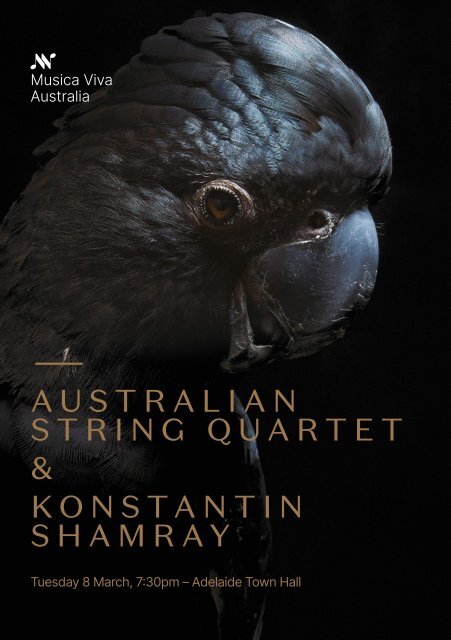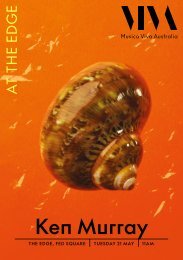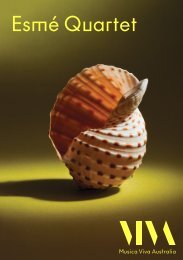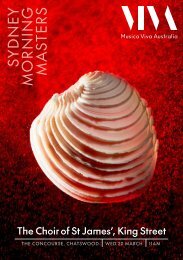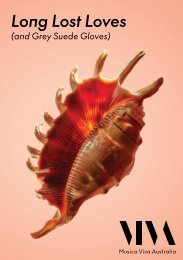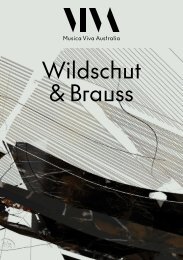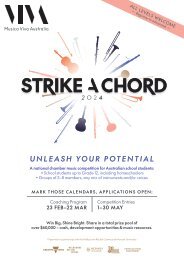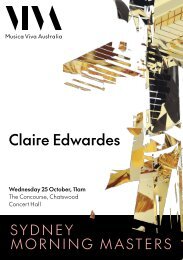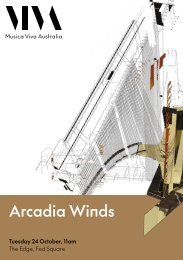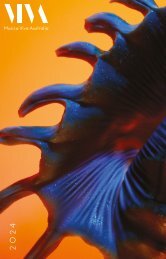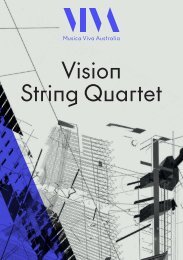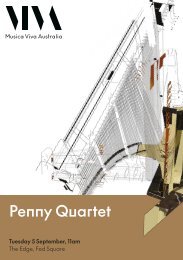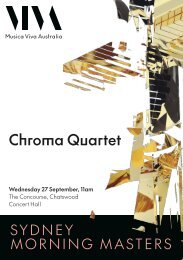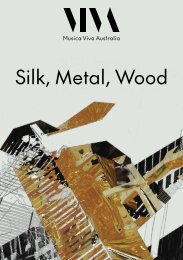Australian String Quartet & Konstantin Shamray Program Guide | March 2022
You also want an ePaper? Increase the reach of your titles
YUMPU automatically turns print PDFs into web optimized ePapers that Google loves.
—<br />
AUSTRALIAN<br />
STRING QUARTET<br />
&<br />
KONSTANTIN<br />
SHAMRAY<br />
Tuesday 8 <strong>March</strong>, 7:30pm – Adelaide Town Hall
2
Musica Viva Australia acknowledges the Traditional Custodians of the many lands on<br />
which we meet, work, and live, and we pay our respects to Elders past and present –<br />
people who have sung their songs, danced their dances and told their stories<br />
on these lands for thousands of generations, and who continue to do so.<br />
PROGRAM<br />
Dmitri SHOSTAKOVICH (1906-1975)<br />
Piano Quintet in G minor, Op. 57 (1940)<br />
I Prelude: Lento<br />
II Fugue: Adagio<br />
III Scherzo: Allegretto<br />
IV Intermezzo: Lento<br />
V Finale: Allegretto<br />
32 min<br />
Ludwig van BEETHOVEN (1770-1827)<br />
<strong>String</strong> <strong>Quartet</strong> No. 9 in C major, Op. 59<br />
No. 3 ‘Razumovsky’ (1808)<br />
I Andante con moto – Allegro vivace<br />
II Andante con moto quasi allegretto<br />
III Menuetto (Grazioso)<br />
IV Allegro molto<br />
33 min<br />
|<br />
3<br />
|<br />
Dale Barltrop<br />
Francesca Hiew<br />
Chris Cartlidge<br />
Michael Dahlenburg<br />
violin<br />
violin<br />
viola<br />
cello<br />
<strong>Konstantin</strong> <strong>Shamray</strong><br />
piano<br />
This concert is presented in association with Adelaide Festival.<br />
With special thanks to the Producers’ Circle and the Amadeus Society for their support<br />
of the <strong>2022</strong> Concert Season, and to our Concert Champions Joan and Ivan Blanchard.
ABOUT THE ARTISTS<br />
<strong>Australian</strong> <strong>String</strong> <strong>Quartet</strong><br />
|<br />
4<br />
|<br />
Since 1985, the <strong>Australian</strong> <strong>String</strong> <strong>Quartet</strong><br />
(ASQ) has delivered unforgettable string<br />
quartet performances for audiences<br />
around the world.<br />
From its home base at the University of<br />
Adelaide, Elder Conservatorium of Music,<br />
the ASQ reaches out across Australia<br />
and the world to engage people with an<br />
outstanding program of performances,<br />
workshops, commissions and digital,<br />
recording and education projects.<br />
The ASQ’s distinct sound is enhanced by<br />
a matched set of 18th-century Guadagnini<br />
instruments, handcrafted by Giovanni<br />
Battista Guadagnini between c.1743 and<br />
1784 in Turin and Piacenza, Italy. These<br />
precious instruments are on loan to the<br />
ASQ for their exclusive use through the<br />
generosity of UKARIA.<br />
—<br />
Dale Barltrop plays a<br />
1784 Guadagnini Violin, Turin<br />
—<br />
Francesca Hiew plays a<br />
1748-49 Guadagnini Violin, Piacenza<br />
—<br />
Chris Cartlidge plays a<br />
1783 Guadagnini Viola, Turin<br />
—<br />
Michael Dahlenburg plays a<br />
c.1743 Guadagnini Violoncello, Piacenza<br />
‘Ngeringa’<br />
© Jacqui Way
© Rohan Thomson<br />
<strong>Konstantin</strong> <strong>Shamray</strong> piano<br />
Praised as an exhilarating performer with<br />
faultless technique and fearless command<br />
of the piano, <strong>Australian</strong>-based pianist<br />
<strong>Konstantin</strong> <strong>Shamray</strong> enjoys performing<br />
with the world’s leading orchestras and<br />
concert presenters.<br />
Born in Novosibirsk, <strong>Konstantin</strong><br />
commenced his studies at the age of six<br />
with Natalia Knobloch. He went on to<br />
study in Moscow at the Gnesin Russian<br />
Academy of Music with Tatiana Zelikman<br />
and Vladimir Tropp, and the Hochschule<br />
für Musik in Freiburg, Germany with Tibor<br />
Szász.<br />
In 2008, <strong>Konstantin</strong> burst onto the concert<br />
scene when he won First Prize at the<br />
Sydney International Piano Competition.<br />
He is the first and only competitor to<br />
date to win both the First and People’s<br />
Choice Prizes, in addition to six other<br />
prizes. In 2011 he won First Prize at the<br />
Bad Kissingen Piano Olympics in Germany;<br />
in 2013, following chamber recitals with<br />
Alban Gerhardt and Feng Ning, he was<br />
awarded the Kissingen Summer Festival’s<br />
coveted Luitpold Prize for ‘outstanding<br />
musical achievements’.<br />
Since then, <strong>Konstantin</strong> has performed<br />
extensively throughout the world. In<br />
Australia, highlights have included<br />
engagements with the Sydney, Melbourne<br />
and West <strong>Australian</strong> Symphony<br />
Orchestras, as well as with the Adelaide<br />
Symphony, with whom he enjoys a special<br />
relationship. Beyond these shores, he<br />
has performed with the Russian National<br />
Philharmonic, the Mariinsky Theatre<br />
Orchestra, Moscow Virtuosi, Orchestre<br />
National de Lyon, Prague Philharmonia,<br />
Belgrade Philharmonic Orchestra and the<br />
Calgary Philharmonic.<br />
Chamber music plays a strong role<br />
in <strong>Konstantin</strong>’s musical career and<br />
collaborations have included tours<br />
with the <strong>Australian</strong> <strong>String</strong> <strong>Quartet</strong>, the<br />
<strong>Australian</strong> Piano <strong>Quartet</strong>, Kristóf Baráti,<br />
Andreas Brantelid, Li-Wei Qin and Leonard<br />
Elschenbroich. He has enjoyed critical<br />
acclaim at the Ruhr Piano Festival and the<br />
Bochum Festival in Germany, the Mariinsky<br />
International Piano Festival and the White<br />
Nights Festival in St Petersburg, the<br />
Huntington Estate Music Festival and the<br />
Musica Viva Festival; and appears with the<br />
Adelaide Festival, the International Piano<br />
Series in Adelaide, the Melbourne Recital<br />
Centre and UKARIA Cultural Centre.<br />
<strong>Konstantin</strong> has also recorded albums on<br />
the Naxos, ABC Classic and Fonoforum<br />
labels.<br />
<strong>Konstantin</strong> is a Lecturer in Piano at<br />
the University of Adelaide’s Elder<br />
Conservatorium of Music.<br />
|<br />
5<br />
|
ABOUT THE MUSIC<br />
|<br />
6<br />
|<br />
After the crisis provoked by the official<br />
denunciation of his opera Lady Macbeth of<br />
the Mtsensk District in 1936, Shostakovich<br />
turned his attention towards chamber<br />
music as a relatively safe vehicle for his<br />
musical thought. In 1938 he composed<br />
the first of his 15 string quartets, and in<br />
1940 premiered his one and only quintet<br />
for piano and strings. The following year, it<br />
was awarded a Stalin Prize: a sure sign of<br />
Shostakovich’s return to official favour, at<br />
least for the time being.<br />
The Quintet is one of Shostakovich’s<br />
most ‘classical’ works: which is not to say<br />
that it is without passionate expression,<br />
but that (as far as we can judge such<br />
obviously subjective matters) it lacks<br />
the autobiographical references and the<br />
touches of irony which can be identified in<br />
many of his other pieces. There is, too, a<br />
classical clarity about the textures which<br />
the composer achieves. The piano and<br />
the string quartet are treated as separate<br />
entities: the piano, for example, starts<br />
the whole work unaccompanied, as if<br />
the strings were not there, making their<br />
first entry a telling moment: and later the<br />
strings lead off the Fugue movement on<br />
their own, highlighting the piano’s longdelayed<br />
entry. When the piano and the<br />
strings do play together, it is without<br />
doubling: if the strings are in full four-part<br />
harmony or counterpoint, the piano usually<br />
adds only one line (sometimes in octaves);<br />
or if the piano has fuller harmony, the<br />
strings are usually in octaves, or reduced<br />
to one or two instruments. The piano<br />
writing itself is kept unusually clear by the<br />
same concentration on extreme high and<br />
low registers that marks Shostakovich’s<br />
orchestral writing. The use of the whole<br />
ensemble in full harmony with the middle<br />
register filled in, is reserved for a single<br />
passage, the climax of the Intermezzo.<br />
The five-movement layout of the work is<br />
an uncommonly original and satisfying<br />
one. It owes nothing to the arch forms<br />
employed by Bartók in the 1920s and<br />
‘30s; instead, it is based on a plan of two<br />
linked pairs of movements surrounding a<br />
central, pivotal Scherzo. The first paired<br />
movements, both in G minor, make up a<br />
prelude and fugue. The Prelude relaxes its<br />
initial intensity in a lightly scored middle<br />
section, and then redoubles it at the end<br />
of the movement. The Fugue, by contrast,<br />
is intense and concentrated throughout.<br />
After these two slow movements, an<br />
effective contrast is provided by the brittle<br />
high spirits and bright B major tonality of<br />
the rondo-form Scherzo. The last paired<br />
movements are an Intermezzo in D minor<br />
and a G major Finale. The Intermezzo<br />
is an outpouring of sustained melodic<br />
writing. The Finale is an engagingly relaxed<br />
affair, based on a couple of catchy but<br />
never quite predictable tunes; though a<br />
note of greater seriousness is struck at<br />
the end of the development section, in<br />
a string passage which quotes a figure<br />
from the climax of the Fugue. One of the<br />
most attractive features of this extremely<br />
attractive movement is its manner of<br />
arrival and departure: sidling in in a<br />
gradual accelerando at the beginning;<br />
disappearing into thin air at the end.<br />
ADAPTED FROM A NOTE<br />
© ANTHONY BURTON
At the outset of his engagement with<br />
the ‘Razumovsky’ quartets, Beethoven<br />
enthusiastically wrote to his publisher<br />
Breitkopf: ‘I am thinking of devoting myself<br />
almost entirely to this type of composition’.<br />
But by the end of 1806 he had clearly<br />
changed his mind: he was working on<br />
the Fourth Piano Concerto, the Fourth<br />
Symphony and the Violin Concerto. It<br />
would be too much to say that he had<br />
lost interest in the quartet medium; still,<br />
this C major quartet, the last of the three,<br />
does appear to have been written a<br />
great deal more quickly than the others,<br />
and is probably the least substantial of<br />
them (though ‘least substantial’, in this<br />
context, is a very relative term). Certainly<br />
the emotional world, and indeed the<br />
musical structure, of the quartet is more<br />
conventional than that of its fellows;<br />
perhaps that is why it was the only one<br />
to enjoy a certain measure of immediate<br />
success with the public.<br />
The mysterious slow introduction is rather<br />
reminiscent of the start of Mozart’s famous<br />
‘Dissonance’ <strong>Quartet</strong> (also in C major).<br />
The first violin and the cello slowly fan out<br />
to the top and bottom of their respective<br />
registers, scrupulously avoiding any trace<br />
of C major, and when a cadenza-like<br />
flourish for the first violin gets the Allegro<br />
under way, it still takes a few bars for<br />
the main key to be fully established. The<br />
development section begins with the initial<br />
violin figure wandering through further<br />
keys and ends with a florid variation of<br />
it; the rest of the movement proceeds in<br />
a more or less orthodox way, but has a<br />
surprise ending in store.<br />
Unlike its predecessors in Op. 59, the C<br />
major quartet does not quote an actual<br />
Russian theme [in homage to Count<br />
Razumovsky, who commissioned them]<br />
but the slow movement is clearly intended<br />
as a piece in the Slavic manner. Or at least,<br />
that is the character of the first theme,<br />
which pervades the whole movement; the<br />
second theme, in C major, is altogether<br />
more at home in Beethoven’s Vienna. The<br />
Andante is a huge, sombre structure, lying<br />
somewhere between ternary and sonata<br />
form, but not satisfactorily accounted for<br />
by either. Since the finale is going to be a<br />
brilliant Allegro molto, there is no particular<br />
point in having a rapid scherzo as the third<br />
movement. Instead, somewhat unusually<br />
for his middle period, Beethoven writes a<br />
minuet which seems to be an invocation of<br />
a graceful bygone era, though it has a trio<br />
section which is somewhat more robust.<br />
After the minuet has returned, a coda<br />
leads to the finale which is a high-powered<br />
combination of fugue and sonata; not one<br />
of Beethoven’s most searching finales,<br />
perhaps, but certainly one of the most<br />
brilliant.<br />
© RICHARD TOOP<br />
|<br />
7<br />
|
We’ve been taking orders and delivering fine<br />
wines to homes all across Australia since 1974.<br />
You won’t find our wine in bottle shops - we’ve<br />
always preferred to cut out the middle man.<br />
If you’re in Mudgee, come and see us at our<br />
beautiful winery and vineyard, try our wines<br />
and enjoy delicious local produce and weekend<br />
lunches in the gardens and grounds.<br />
As a friend of Musica Viva Australia, you are a<br />
friend of ours too, so take 20% off your first<br />
Huntington Estate order with coupon code<br />
MVAFRIEND, online or in our charming Cellar<br />
Door.<br />
641 ULAN ROAD BUCKAROO NSW 2850<br />
WWW.HUNTINGTONESTATE.COM.AU<br />
The Picture of<br />
Dorian Gray<br />
By Oscar Wilde | Sydney Theatre Company<br />
Directed by Kip Williams<br />
Starring Eryn Jean Norvill<br />
13 - 20 Mar<br />
Book your tickets now<br />
adelaidefestival.com.au<br />
Presenting Partner<br />
★★★★★<br />
“Eryn Jean Norvill<br />
dazzles in this ambitious,<br />
whip-smart production.“<br />
The Guardian
Music brings us together<br />
At Musica Viva Australia we are proud to share<br />
exceptional music with audiences of every age,<br />
location and circumstance — it’s what we have<br />
always done, and what we will always strive to do.<br />
With your contribution, we can support our<br />
professional musicians, introduce children to<br />
live music in schools, commission new works,<br />
create innovative and engaging online content,<br />
and develop future generations of artists.<br />
Scan the QR code to give today.<br />
Contact us on philanthropy@musicaviva.com.au<br />
Melbourne’s Finest<br />
Afternoon Tea Experience<br />
Discover The Langham Afternoon Tea at Aria Bar & Lounge and<br />
indulge in a selection of British tea time classics with a modern twist.<br />
#LovingLangham #CelebrateTheEveryday<br />
1 Southgate Avenue, Southbank, Vic 3006 Australia<br />
T (61) 8696 8888 F (61) 9690 5889<br />
langhamhotels.com/melbourne
SA SUPPORTERS<br />
|<br />
10<br />
|<br />
CUSTODIANS<br />
Monica Hanusiak-Klavins & Martin Klavins,<br />
Anonymous (4)<br />
LEGACY DONORS<br />
The late Edith Dubsky, The late John Lane Koch<br />
ENSEMBLE PATRONS<br />
Our artistic vision for <strong>2022</strong> is made possible thanks to the<br />
extraordinary generosity of our Ensemble Patrons, each<br />
of whom supports the presentation of an entire national<br />
tour for our <strong>2022</strong> Season.<br />
Ian Dickson & Reg Holloway (Van Diemen’s Band)<br />
Anonymous (Paul Grabowsky & Andrea Lam)<br />
Peter Griffin AM & Terry Swann<br />
as part of The Travellers - Giving Circle<br />
(A Winter’s Journey)<br />
<strong>Australian</strong> Music Foundation (Z.E.N. Trio)<br />
Eleanore Goodridge OAM<br />
(Avi Avital & Giovanni Sollima)<br />
CONCERT CHAMPIONS<br />
The mainstage concerts of our <strong>2022</strong> Season are brought<br />
to life thanks to the generosity of our Concert Champions<br />
around the country.<br />
Joan & Ivan Blanchard; Helen Fulcher, Anonymous,<br />
Helen Bennetts & Tim Lloyd, Leonie Schmidt & Michael<br />
Davis, The Late Lesley Lynn, Michael Szwarcbord &<br />
Susan Marsden, Anonymous<br />
PRODUCERS’ CIRCLE<br />
Darin-Cooper Family Foundation<br />
MASTERCLASSES<br />
GIVING CIRCLE<br />
The Masterclasses Giving Circle is a group of generous<br />
donors whose collective support will enable the artistic<br />
development of the next generation of <strong>Australian</strong><br />
chamber musicians.<br />
Nicholas Callinan AO & Elizabeth Callinan, Caroline &<br />
Robert Clemente, Ian & Caroline Frazer, Allan Myers<br />
AC QC & Maria Myers AC, Patricia H. Reid Endowment<br />
Fund, Andrew Sisson AO & Tracey Sisson, Mick &<br />
Margaret Toller, Anonymous (2)<br />
COMMISSIONS<br />
Musica Viva Australia acknowledges and celebrates<br />
those individuals and collectives who have generously<br />
committed to commissioning new music in <strong>2022</strong>/23 to<br />
be enjoyed by us all.<br />
In loving memory of Jennifer Bates; Julian Burnside<br />
AO QC & Kate Durham; The Barry Jones Birthday<br />
Commission; Michael & Fréderique Katz, in honour of<br />
Cecily Katz; Graham Lovelock & Steve Singer; DR & KM<br />
Magarey; Vicki Olsson; Tribe family in honour of Doug<br />
Tribe’s 75th birthday<br />
Musica Viva Australia also thanks the Silo Collective,<br />
the Ken Tribe Fund for <strong>Australian</strong> Composition, and<br />
the Hildegard Project for their support in bringing new<br />
<strong>Australian</strong> works to life.<br />
RESIDENCY & EDUCATION<br />
SUPPORTERS<br />
Aldridge Family Endowment, Carclew, The Department<br />
of Education SA, Carthew Foundation, Day Family<br />
Foundation, FWH Foundation, Jennifer & John<br />
Henshall, Klein Family, Lang Foundation, LK Law,<br />
Marsden Szwarcbord Foundation, Seeley Foundation<br />
MAJOR GIFTS<br />
$10,000-$19,999<br />
Anonymous<br />
$5,000-$9,999<br />
Jennifer & John Henshall, Galina Podgoretsky,<br />
in memory of Rodney Crewther, Anonymous<br />
ANNUAL GIVING<br />
$2,500-$4,999<br />
DJ & EM Bleby, Peter Clifton, Ms Judy Potter & Dr<br />
George Potter, STARS, Anonymous<br />
$1,000-$2,499<br />
The Late Peter Bailie & Ann-Maree O’Connor, Ivan<br />
& Joan Blanchard, Richard Blomfield, Max & Ionie<br />
Brennan, John & Libby Clapp, Dr Iwan Jensen, The Hon.<br />
Christopher Legoe AO QC & Mrs Jenny Legoe, Fiona<br />
MacLachlan OAM, Dr Leo Mahar, Ann & David Matison,<br />
Diane Myers, H & I Pollard, Trish & Richard Ryan AO,<br />
Anne Sutcliffe, Anonymous (3)<br />
$500-$999<br />
Terence & Caroline Donald, Daniel & Susan Hains,<br />
Lesley Haas-Baker, Elizabeth Ho OAM, in honour of the<br />
late Tom Steel, Helga Linnert & Douglas Ransom, Joan<br />
Lyons, Ruth Marshall & Tim Muecke, Linda Sampson,<br />
Anonymous (5)<br />
We sincerely appreciate the<br />
generous support we receive from<br />
our incredible community, and<br />
encourage you to scan the QR<br />
code to see a full list of donors over<br />
$500 to Musica Viva Australia.<br />
We thank all our audience members who donated the<br />
value of their cancelled tickets towards the Artists’ Fund.
PARTNERS<br />
Perth Concert Series<br />
Sydney Morning Masters Series<br />
Law Firm<br />
Chartered Accountants<br />
Piano & Tuning<br />
Media<br />
|<br />
11<br />
|<br />
Wines<br />
Hotels<br />
National Government<br />
Musica Viva Australia is a not-for-profit organisation endorsed<br />
by the <strong>Australian</strong> Taxation Office as a Deductible Gift Recipient<br />
and registered with the <strong>Australian</strong> Charities and Not-for-profits<br />
Commission (ACNC).
2<br />
V<br />
0<br />
I<br />
2<br />
V<br />
2<br />
A<br />
VAN DIEMEN’S BAND<br />
Touring: 26 April–14 May<br />
musicaviva.com.au/van-diemens-band | 1800 688 482<br />
—<br />
Australia’s finest early music specialists invite you to experience<br />
the beautiful melding of cultures in Europe’s historical borderlands.<br />
—<br />
With special thanks to our Ensemble Patrons Ian Dickson & Reg Holloway.


